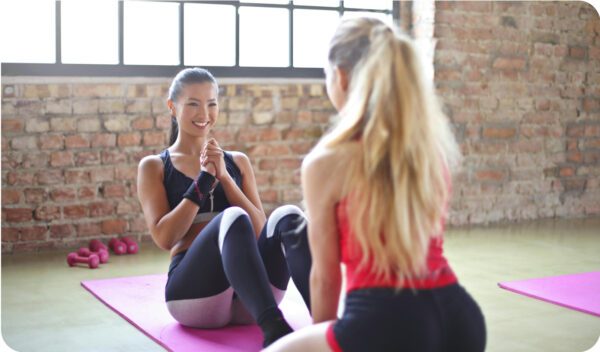We all know how life can get hectic and derail our fitness goals. Work meetings run late, the kids need help with homework, and that weeknight dinner just won’t make itself. Exercise? It often slips to the bottom of the priority list. You might promise yourself a solo Saturday workout, but by the time Saturday rolls around, life has inevitably rearranged your plans—and your workout is the first thing to go. That can all change with a workout buddy!
But what happens when someone else is counting on you? Imagine committing to a 30-minute walk with your best friend or biking through the park together. Canceling isn’t so easy when someone’s waiting for you, right? It turns out that having a workout buddy doesn’t just keep you accountable—it can actually increase your success. Research, psychology, and personal stories all point to one truth: fitness is better with friends.
The Psychological and Motivational Benefits
The Power of a Workout Buddy: How It Can Transform Your Mindset
Exercising alone can sometimes feel like an uphill battle. The motivation wanes, and it’s all too easy to hit snooze on early-morning plans or swap gym time for Netflix. Enter the workout buddy—a game-changer, transforming exercise from a chore into a shared experience.
Your perspective shifts when you know someone is investing their time alongside yours. You’re no longer just exercising for yourself but fulfilling a shared commitment. Even when those ‘I don’t feel like it’ days come along, the thought of not wanting to disappoint your partner can push you to show up. This shared commitment instills a sense of responsibility and dedication in you. And when you both achieve your fitness goals, the sense of accomplishment is truly rewarding.
The “Buddy Effect” on Motivation and Performance
Studies show that people who exercise with a buddy are more likely to push themselves further than those who go solo. This phenomenon, often called the “buddy effect,” taps into the positive influence of shared energy. When your friend grits it out during the last set of squats, you’re inspired to do the same—maybe even adding an extra rep or two.
Having an exercise buddy motivates you to stay consistent, improves the quality and intensity of your workouts, and helps you see results faster.
Simple Workouts, Big Results
Daily Caloric Deficit and the Role of Daily Activities
Maintaining a healthy lifestyle doesn’t require grueling gym sessions or daily two-hour workouts. Simple activities like taking a brisk walk or biking can burn calories while helping you work toward your weight loss or fitness goals.
Whether walking with a friend after dinner or riding bikes in the morning, these leisurely activities can make a significant dent in your daily caloric deficit. The best part? You’re enjoying the process instead of focusing solely on “burning calories.”
Weekly Fitness Goals and Strategies for Achieving Them
Consistency matters more than perfection. Instead of trying to exercise every day, set realistic weekly goals. Even meeting up with your exercise buddy once or twice a week for a yoga session or a weekend hike can make a huge difference over time.
Here’s the key takeaway: fitness goals don’t happen overnight. They’re achieved through small, sustainable steps—and having a partner to share that progress with keeps you moving forward.
Accountability and Consistency
How Workout Buddies Hold You Accountable
Accountability is one of the biggest factors in sticking to a workout routine, and having a partner creates an external layer of responsibility. You may not mind canceling plans on yourself, but the thought of letting someone else down? That’s a harder pill to swallow.
This accountability isn’t just physical—it’s emotional, too. You’ll check in, share struggles, celebrate wins, and develop a consistency that solo fitness often lacks.
Consistency Through Commitment and Partnership
When workouts become part of connecting with a friend, they shift from a task to an anticipated ritual. Your commitment to your fitness buddy reinforces your consistency—and vice versa. Missed workouts become less frequent, and over time, adding workouts to your schedule can enforce habits rather than always looking at a workout as a chore.
Tip: If you’re staying consistent, you’ve found what works for your schedule and energy. Rotate activities with your buddy to keep things fresh and exciting.
The Social Aspect and Enjoyment Factor
Connecting and Bonding Through Exercise
There’s something special about catching up with a friend during a walk or run. Additionally, conversations naturally flow when you’re moving together, creating a sense of camaraderie and connection.
What’s more, fitness routines can serve as the foundation for deeper relationships. The goal isn’t just exercise for weight loss—it’s bonding. Whether you’re tackling a hiking trail or laughing through a virtual workout class, your shared experiences make workouts feel less like work and more like a joyful journey you’re taking together.
Making Workouts Fun: From Chats to Challenges
Adding fun and creativity makes exercise even better. For example, here are some ideas to infuse enjoyment into your fitness routine with a buddy:
- Host a dance-off in your living room—kids welcome!
- Play pickleball for a mix of cardio and competition.
- Challenge each other with fitness goals, like a step count competition or trying a new workout class.
- Seasonal workouts like spring hikes or winter sledding make health journeys exciting and change-friendly.
Who said workouts have to stay the same all year long? Playful fitness is rewarding fitness.
Finding the Right Fit: Tips for Choosing a Workout Buddy
Similar Goals, Different Strengths
The best workout buddy is someone whose goals align with yours. Looking to lose weight? Find someone with a similar focus. Want to add strength training? Your buddy might already be familiar with a great gym routine.
At the same time, different strengths can complement one another. Perhaps your friend motivates you mentally while you’re better at organizing and planning. Together, you push each other toward progress.
Scheduling and Communication Tips
Clear communication with your training partner is crucial. Discuss fitness goals, schedules, and workout preferences before committing. Having a routine (e.g., morning walks every Tuesday/Thursday) clears up uncertainty and keeps both parties on track. And remember, life happens. Be flexible but committed—missing one session doesn’t mean giving up altogether.
The Journey Ahead: Committing to a Healthier, Happier Lifestyle
Fitness doesn’t have to be a lonely endeavor. Whether you’re looking to stick to an exercise routine, enhance your performance, or simply make the process more enjoyable, a workout buddy can make all the difference.
By shifting your mindset, focusing on realistic goals, and cultivating the social joy of shared experiences, you’re setting yourself up for long-term success.
Are you ready to bring a buddy along for the ride? Start small. A single walk could grow into a lifelong fitness partnership where every step feels just a little lighter.
Your friend is waiting—so what are you waiting for?





